(1981,US)

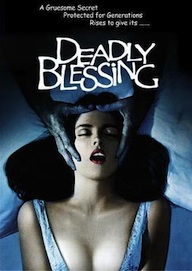

Is it or isn’t it? A slasher movie, I mean. Perhaps almost every horror film released in 1981 was touched by the hand of slash, but rewatching Wes Craven’s DEADLY BLESSING its apparent allegiance to the subgenre becomes ever more apparent. Maybe it’s the film’s tagged on supernatural full stop that has meant that it is rarely considered a slasher film per se. But let's see …
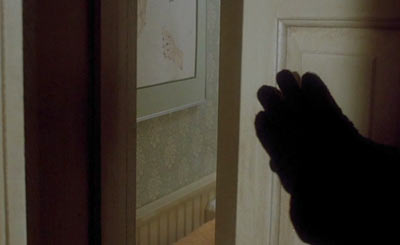 |
|
| A black gloved killer and a prowling POV camera. It must be a slasher movie, right? |
Admittedly, DEADLY BLESSING is unique in its setting and much of its theme. Beating WITNESS (1985) to the punch by several years, it was one of the first films to examine the reclusive Amish community – or in this case the even more orthodox Hittites.
Neighbouring their land are a young married farming couple: city girl Martha (Maren Jensen) and her husband Jim (Douglas Barr), who is an ex-Hittite and so therefore rejected by the local community. Their neighbours are the man-hating (but otherwise amiable) waitress Louisa (Lois Nettleton) and her somewhat eccentric teenage daughter Faith (Lisa Hartman) – who one of the young Hittites (Michael Berryman) is convinced is an incubus. The Hittites are led by Jim’s estranged father (the late Ernest Borgnine), who becomes increasingly convinced that evil spirits are afoot.
Martha and Jim put this down to superstition, but one night he is crushed to death by his own tractor in a barn. The camera’s lengthy prowling POV shot around the house and outbuildings will be familiar to anyone who has ever seen a slasher movie from the time – and it is a technique used extensively within the film. Jim’s death is wrongly thought to be a tragic accident, but it brings Martha and the Hittites no closer – in fact they try and purchase the farm from her. To cheer her up two old college friends arrive from LA: Lana (Sharon Stone) and Vicky (Susan Buckner).
However, whoever – or whatever – killed Jim is clearly not done and more locals are cut down with increasingly frenzied knife attacks …
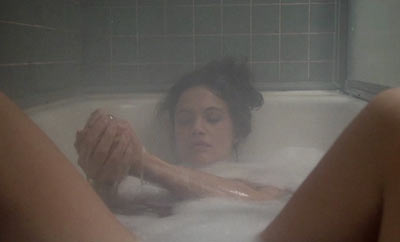 |
|
| Wes Craven loved this between-the-legs bath shot so much in DEADLY BLESSING that he recycled it a few years later in A NIGHTMARE ON ELM STREET |
Sometimes it is tempting to view a film as the sole work of the director, even though we know that they are really a collective work borne of many people. Wes Craven was actually a director-for-hire here (unlike his follow-up A NIGHTMARE ON ELM STREET (1984) which really was his ‘baby’), and had no input in the gestation of the story. In fact, funding was already in place when he became attached to the project.
Reportedly, Craven felt that there was too much going on in the script – and to his credit he does the best to fix it. However, despite this, DEADLY BLESSING – like much of Craven’s output – is wildly uneven in tone. The ideas are certainly interesting: of pitching good nature against intolerance; common sense against faith; and townies against country folk (the latter more or less a similar notion to Craven’s own THE HILLS HAVE EYES (1977)). However, the truth of the matter is that the portrayal of the Hittites just isn’t interesting enough to sustain the film’s running time. The irony is that they are essentially a giant red herring (at least in the original script).
Without giving it away, the identity of the killer is sensationalist but still earthbound. The supernatural twist ending (inspired by CARRIE (1976)) that was forced on Craven by the producers of the film essentially turns everything on its head. Whilst the whole setup for the film was that the Hittites were wasting time looking for a demon in human form, the real killer is very much flesh and blood – whereas the tacked on ending ironically actually gives credence to the exact fears of the supernatural that the scriptwriter was lampooning.
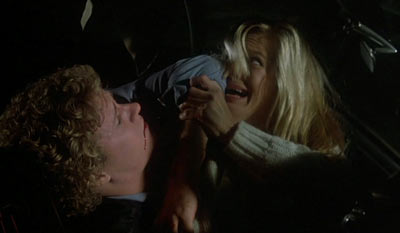 |
|
| A necking couple fall foul of a mad slasher in Wes Craven's DEADLY BLESSING |
Where Craven excels - in a similar way to say Dario Argento - is the film's excellent horror and suspense set pieces. Standout scenes include the genuinely unnerving section where Sharon Stone becomes trapped in the barn, when what little light left is systematically extinguished as the windows are shut from outside - leaving her inside in the dark with spiders and someone, or something, lurking there with her.
Craven also exploits the innate fear of creepy-crawlys for all he's worth. Perhaps most memorably the nightmare sequence where a plump spider plops into Stone's screaming mouth. It is a moment that garners nearly the same reaction as the infamous chisel-to-tooth scene in his earlier LAST HOUSE ON THE LEFT (1972).
In DEADLY BLESSING Craven flirts with nightmare imagery and logic as almost a dry run for his next more famous outing. Indeed, he recycled the scene where Martha is menaced in the bath (right down to the identical shot between her legs) in A NIGHTMARE ON ELM STREET.
Craven isn't above an in-joke. A character goes to see the director's SUMMER OF FEAR (1978) - the joke being that it was a TV movie and so was unlikely to have played theatrically. This and other slightly more playful touches show that Craven was happy to veer away from the grimmer mood and themes of some of his earlier work.
Curiously, the Hittites become hysterical because they believe that an incubus is in their midst and they try and finger Faith (as it were) at the beginning of the film. Later on other women are suspected, but as anyone who's seen the INCUBUS (1982) (whose eponymous villain wielded a massive phallus, at least in the novel) will know that an incubus is a male demon. However, as the film progresses it becomes clear that perhaps this isn't a mistake on behalf on the scriptwriter's part and more of a sign post towards the film's pre-supernatural conclusion.
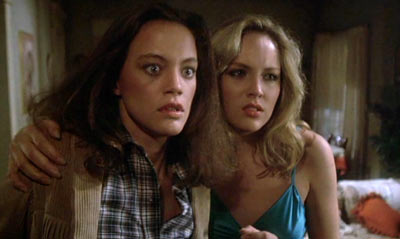 |
|
| Martha (Maren Jensen) and Lana (Sharon Stone) prepare to face off against the killer |
Despite its deliberately off-kilter vibe, DEADLY BLESSING features a number of scenes that would have looked right in place in any number of straight out slasher films from the period. That includes one where a necking couple are attacked in their car by an assailant with a flashing blade. It is clear that the success of the subgenre at the time - and this film's many similarities - made it an attractive proposition and maybe explains why it was financed seemingly so effortlessly. Without spoiling the identity of the killer, it's suffice to say that Grand Guignol showdown brings to mind the similar frenzy of the same year's NIGHT WARNING. Indeed, without the aforementioned supernatural coda DEADLY BLESSING would be acknowledged more widely for the slasher film it really is.
Startlingly beautiful, Sharon Stone in what amounts to her first major dramatic role, veers from the amateurish to actually very effective (she reputedly briefly fell out with Craven who, again like Argento, is not an actor's director). Jensen is also pretty good as the protagonist. She was best known for her role in TV's original BATTLESTAR GALACTICA, but - for whatever reason - this was her last credited acting role. Michael Berryman tells a funny story about what a bitchfest this film was, with the beautiful actresses all vying for attention - although he coyly refuses to name the worst offenders.
DEADLY BLESSING was cast in May 1980 and began shooting outside Houston in November of the same year. It was a moderate success on its release in August 1981. Copying the model set by Paramount with FRIDAY THE 13TH (1980) and its sequels, United Artists released it wide to 3,000 screens in the US. However, immediately afterwards Craven struggled to replicate even this film's meagre financial success. After wrapping DEADLY BLESSING he worked on an adaptation of Poe's THE PIT AND THE PENDULUM, which never came to pass and found his own NIGHTMARE project a hard sell until the tail end of the Golden Age of the slasher movie. The rest, as they say, is history.
BODYCOUNT 6  female:2 / male:4
female:2 / male:4
1)
Male crushed by tractor
2) Male stabbed to death
3) Male stabbed in the back
4) Female killed in explosion
5) Female shot dead
6) Male stabbed in the back